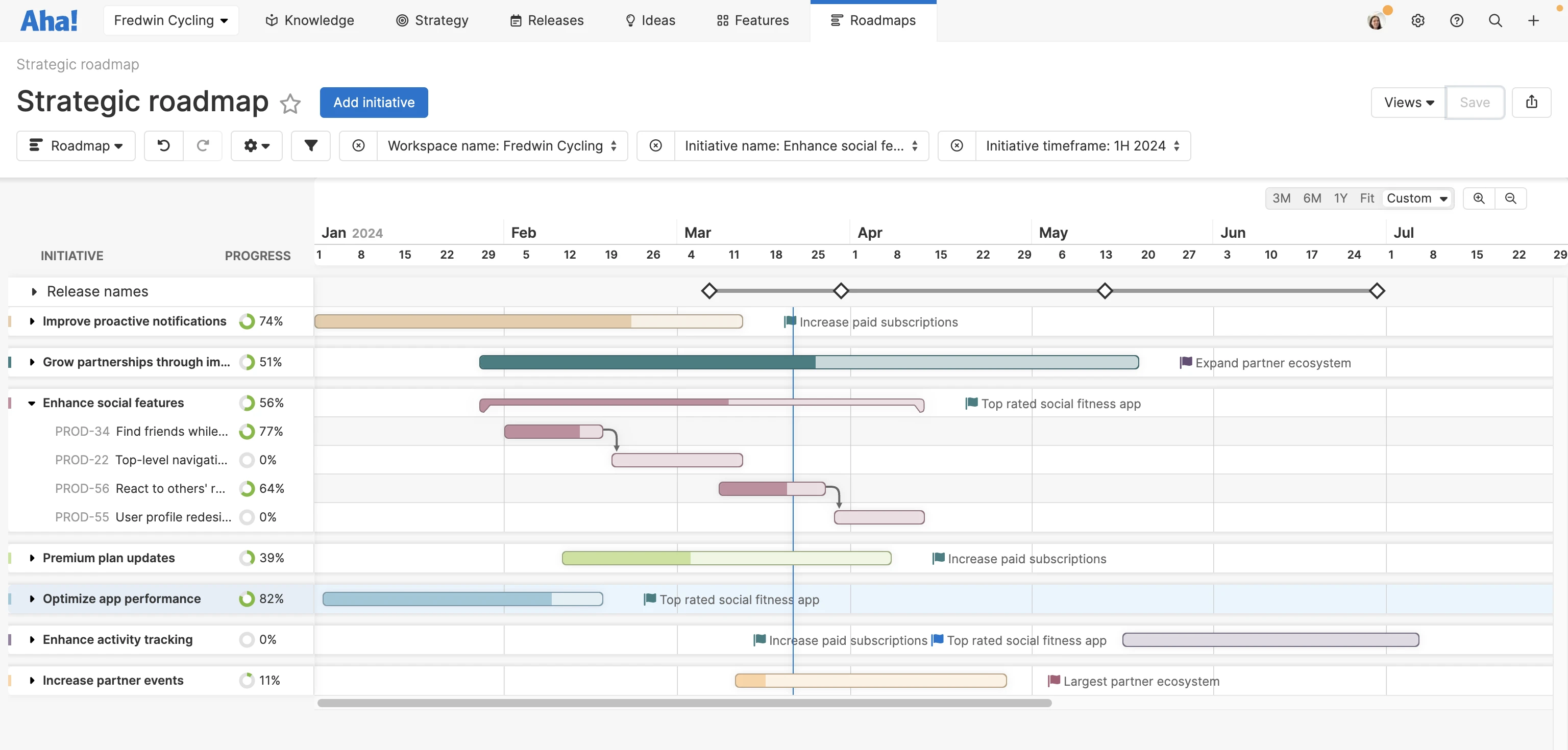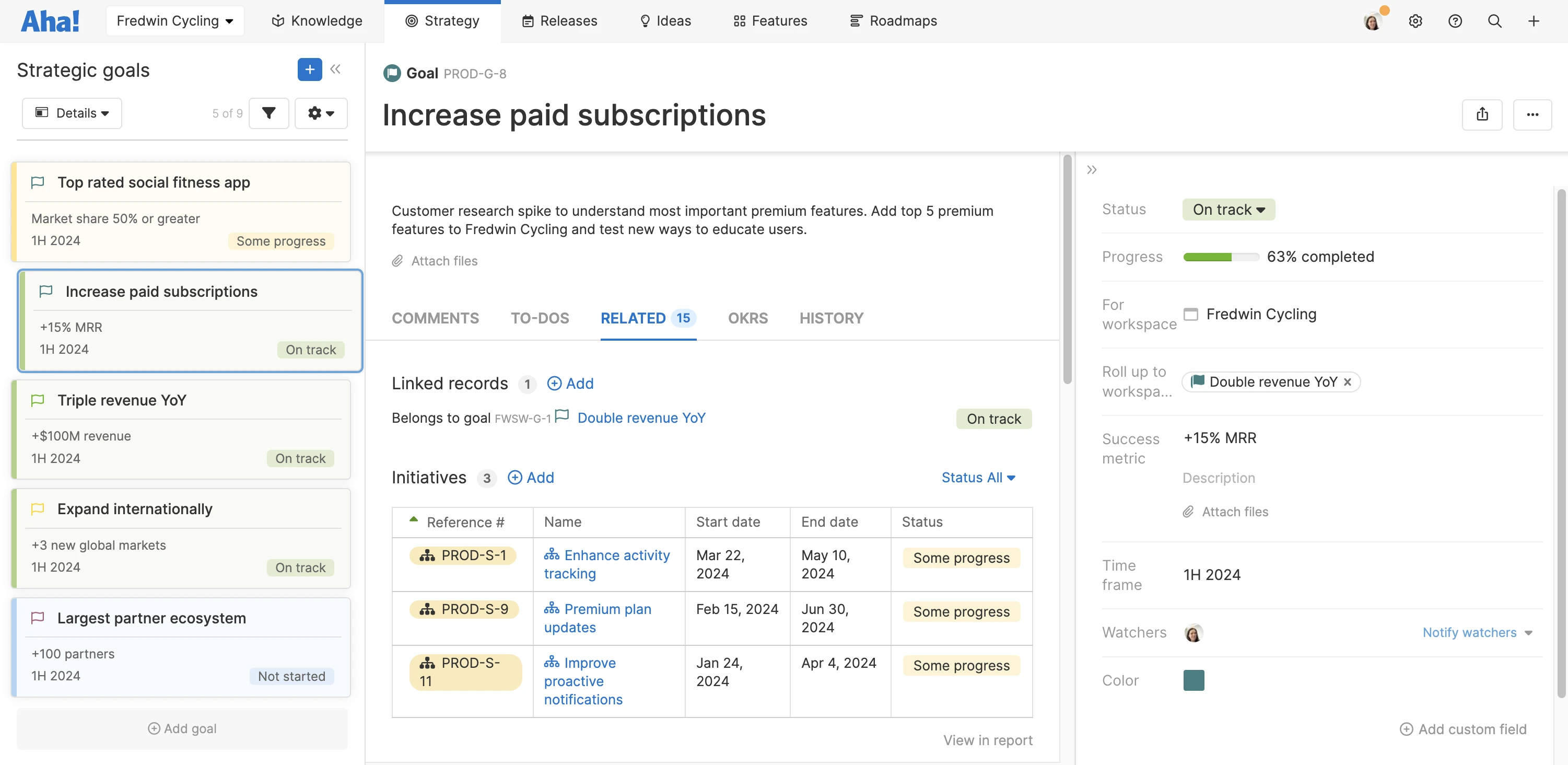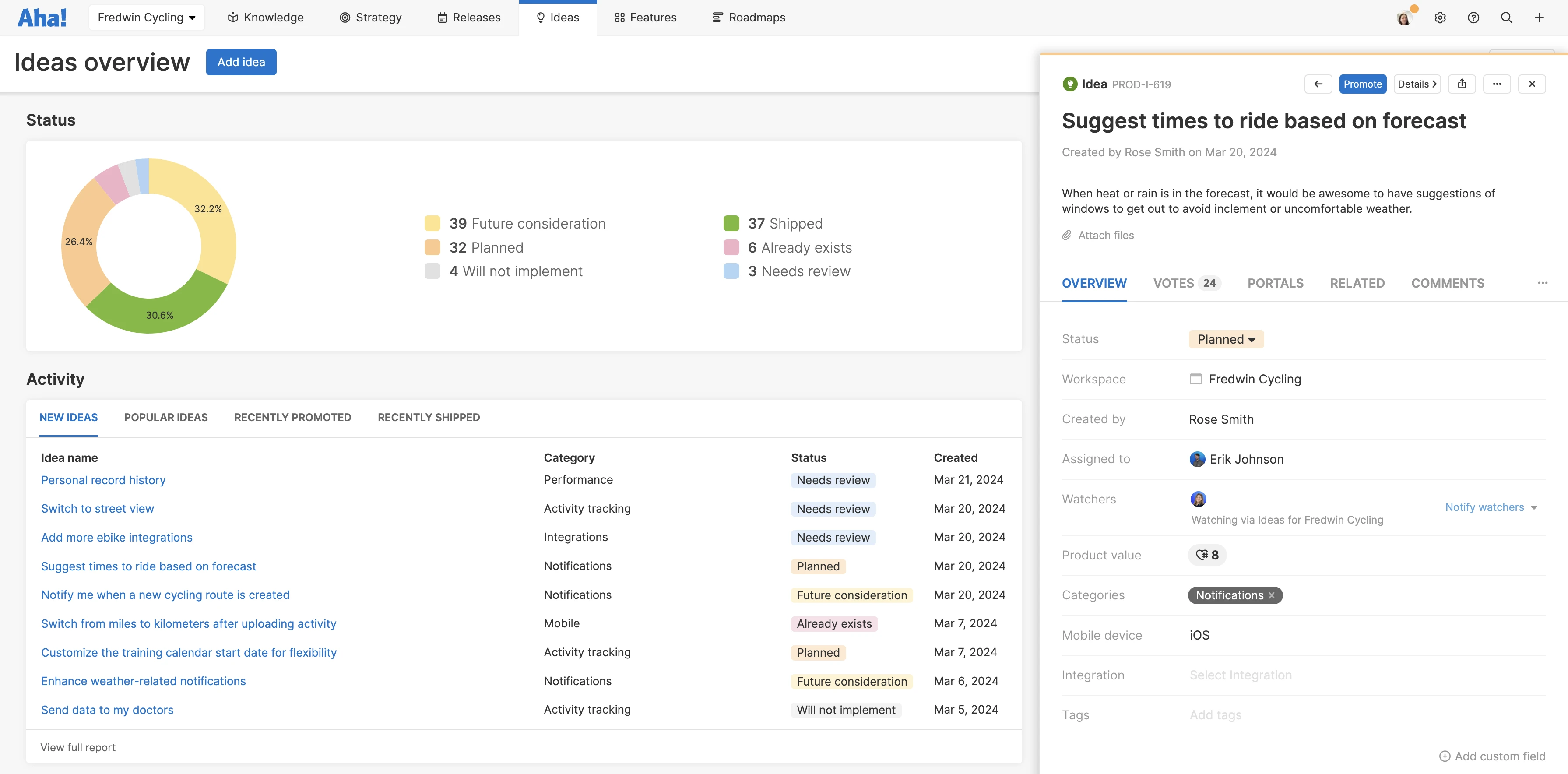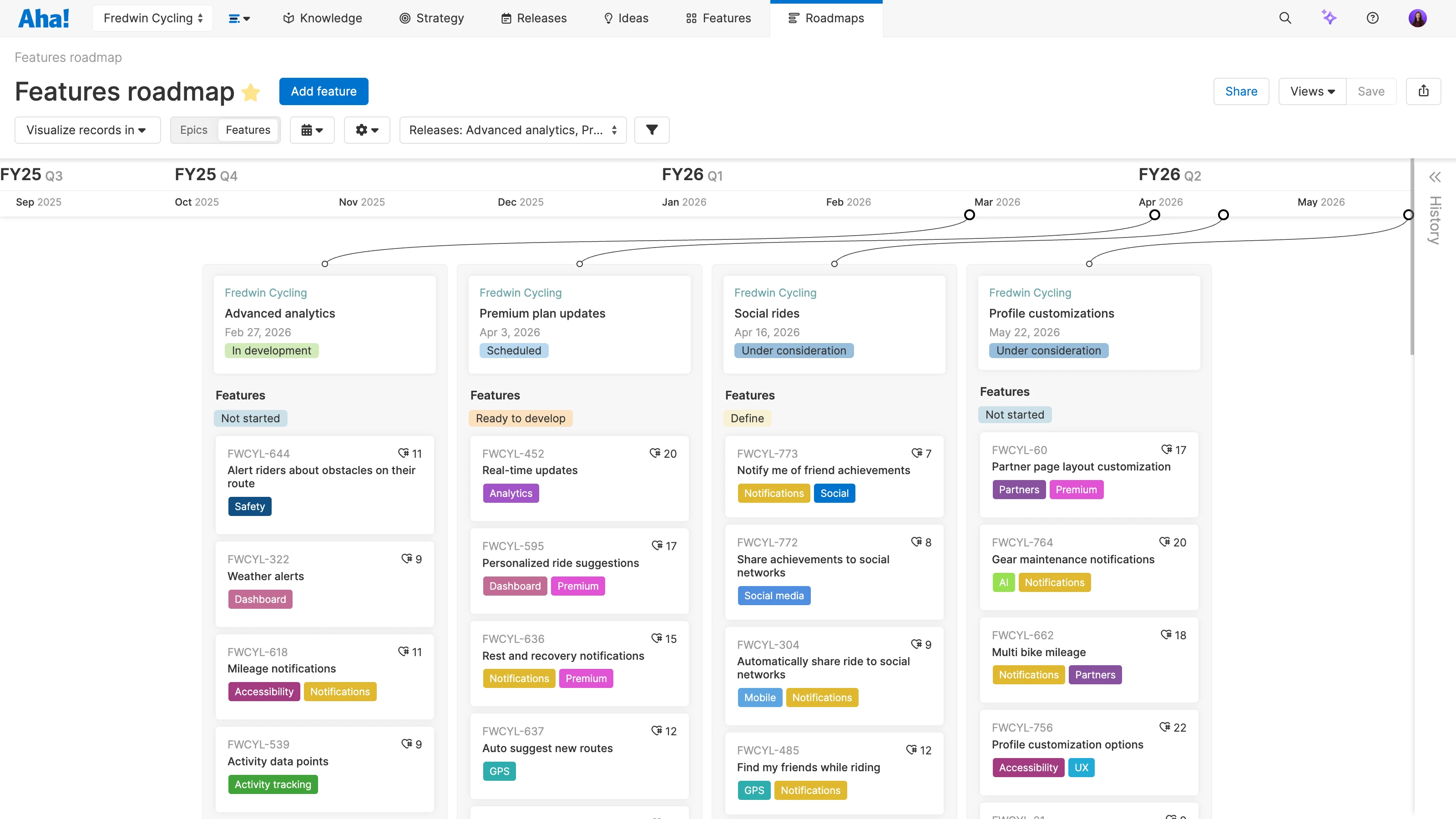Product goals represent tangible, noteworthy achievements on the way to making your vision a reality. Many organizations set new product goals annually, bi-annually, or quarterly.
2. Reconfirm your product vision and how it relates to the business vision
Product vision is the essence of why your product exists and forms the beginning of your strategy. For example, our vision at Aha! is simple: We aspire for a world of lovable software built by happy teams. This has been our vision since the start and drives our values and strategic direction.
Confirm again that your vision is still true for you. Make sure it directly aligns with your organization's broader vision and objectives. When product and business vision are in sync, the team has a clear purpose — reinforcing that product success is fundamental to overall business success.
This could also be a good time to revisit foundational information such as product positioning, customer personas, and competitive analysis. Getting a full picture of the market that you operate in and potential opportunities will help you better define your go-forward plans.
Related:
3. Set product goals and initiatives for the year
Now, you can more concretely establish what you want to achieve. Goals and initiatives are the earliest building blocks of your roadmap, helping to propel you toward your desired future state.
Product goals represent what you want to accomplish and how you will measure success. They should be easy to understand, actionable, and have a fixed time frame (spanning anywhere from three to 12 months).
Product initiatives specify the broad themes of work you will complete to reach your goals.
Different teams use different goal-setting frameworks, such as SMART goals or OKRs. No matter which framework you use, it is important that product goals align with company-level goals to show how work at the product level impacts the organization.
Let's look at an example for Fredwin Cycling, a fictitious social fitness company:
Business goal | Increase market share in the cycling app industry | Success metric: +100 partners |
Product goal | Build the largest partner ecosystem in the market | Success metric: New marketplace launched |
Product initiatives | |
As you think about product goals and initiatives, a useful exercise for identifying the most impactful goals is to plot out potential on a chart noting the investment needed (from your team) and the impact (for your customers). This same exercise works well at other junctures in planning, such as when you are prioritizing product features.
Related:
4. Get leadership's alignment
Securing alignment from top leadership at this stage is paramount. Decision makers and executive leaders — including the CEO, Chief Product Offer, Chief Information Officer, Chief Technology Officer, and others — hold the metaphorical keys to the necessary resources, expertise, and cross-functional support needed to successfully implement the roadmap.
Invite stakeholders to validate your goals and initiatives and offer insights about overall business strategy and market trends. Here is a short list of questions you might consider discussing:
Are there any shifts in the overall company strategy that might influence our product direction?
What budget and resources are available for the upcoming year, and how might they impact our product planning?
Are there any updates or improvements needed in the existing technology infrastructure to support our product initiatives?
Are there specific design considerations or trends that stakeholders believe should be incorporated into the product?
What potential risks or obstacles do stakeholders foresee during the upcoming year, and how can we proactively address them?
Are there any external factors, such as regulatory changes, that might impact the product roadmap?
Are there emerging trends or technologies that stakeholders believe should be considered for long-term planning?
Discussing these topics will give you a more comprehensive understanding of stakeholders' perspectives as you get into deeper roadmap planning. It will also help you tailor your eventual roadmap presentation to the priorities and concerns that these stakeholders have.
Related:
5. Identify how you want to help customers be successful
The next step in roadmap planning involves deeply understanding how the work you will focus on in the year ahead will help your customers do what they need to — some refer to this as "jobs to be done" (JTBD). This concept entails dissecting the core tasks and challenges your product is designed to solve for customers. Identifying these crucial "jobs" is the lighthouse that guides what you will build so that your product remains aligned with what users need.
Let's revisit one of the example product initiatives for Fredwin Cycling: "Enhance partner portal." Example jobs to be done by partners might include:
Core task/challenge | Jobs |
Efficient content access | Find and access marketing materials, product documentation, and resources relevant to promoting our cycling app Collaborate with our marketing team to plan and execute joint marketing campaigns, aligning promotional efforts for mutual success
|
Streamlined onboarding and communication | Enjoy a smooth onboarding experience complete with step-by-step guides and essential information Access training materials and certification programs to enhance knowledge of our cycling app, ensuring they can effectively communicate its features and benefits Communicate seamlessly with our team, getting quick responses to inquiries, support requests, and updates about new features or campaigns
|
Lead generation tools and campaign tracking | Utilize tools and features within the partner portal for lead generation, tracking, and managing potential customers interested in our cycling app Monitor the performance of their specific marketing campaigns, tracking metrics such as click-through rates, conversions, and user engagement
|
As you move ahead to the next stages in the planning process, you will get a better sense of how to prioritize these jobs based on business value, customer feedback, and feasibility. The idea is to strike a balance between addressing immediate and longer-term needs.
6. Review customer feedback
Ideally, you have an idea management process in place and a central portal where customers can submit their feedback and requests. This makes it easy to collect feedback from a variety of sources and review it alongside your product backlog.
You want to look for common themes and recurring pain points within the feedback. It is also useful to assess how popular certain requests are or if particular customer segments are asking for similar things. That way, you can better understand how widespread a need is and use that data to inform prioritization decisions.




